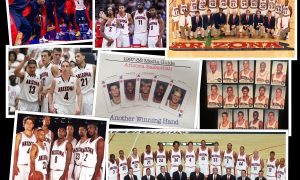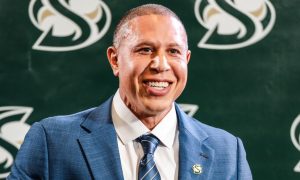The third and final installment of our Arizona Wildcats Top 10 Hoops Badasses includes our top three players — the toughest and meanest and some of the most dominant rebounders in the history of Arizona’s program.
They owned the paint and did not let allow a rebound to slip away. Their mere presence made opposing players know they were in for a long night, winning that important psychological fight.
None were taller than 6’9″ but they played bigger than guys who were 6’11” and 7’0″.
Catch up on the top 10 list by viewing the Nos. 10 through 7 selections by clicking here. The Nos. 6 through 4 ranking can be viewed here.
The list was inspired by the popularity of our ranking of Arizona’s Top 10 Football Badasses.
No. 3 Pete Williams

A historic day in the UA hoops program — the day Lute Olson and assistant Ken Burmeister (far left) signed Pete Williams in 1983 (Pete Williams photo)
Height-for-height and pound-for-pound Arizona has never had a more tenacious rebounder at the post position than Pete Williams.
He was listed at only 6’7″ and 190 pounds, a very slender, yet strong and physically gifted player who held his own against 7-foot space-eaters inside the paint.
Lute Olson, to this day, calls Williams the best rebounder he coached at Arizona. That’s saying something because Williams played in Olson’s first two seasons in Tucson in 1983-84 and 1984-85. Great rebounders such as Anthony Cook, Ben Davis, Michael Wright, Channing Frye and Jordan Hill followed in Olson’s 24 years as head coach.
“Pete had an uncanny nose for the ball,” former teammate Craig McMillan, now coach at Santa Rosa (Calif.) Junior College, told former Tucson Citizen reporter Steve Rivera in a 2005 interview.
“He was barely 6-foot-7 and not very heavy, yet he got every rebound humanly possible. He was quick, aggressive and had great timing. All he thought about was rebounding.”
Williams has the best rebounding average in Arizona’s Pac-10/12 era at 9.2 per game, followed by Wright’s 8.4.
He was not only a workhorse on the glass but he did not give an inch when positioning inside. The combination of put-backs and scoring inside allowed Williams to shoot an Arizona-record 60.5 percent from the field in his two-year career after transferring from Mount San Antonio College in Walnut, Calif.
“Looking back to when I was a high school senior and to think not only would I play in the Pac-10 after being a fan of the Pac-8 growing up, and then having an impact is incredible to me,” Williams told Rivera. “It’s unreal the things I was able to accomplish. But a lot was based on Coach Olson. I had to show him I could play and that I wasn’t going to let him down.”
Williams, 51, works as a probation officer for the San Bernardino County Probation Department.
If anybody can set wayward youngsters straight, it’s Williams, who showed the good side of being a badass with how he overcame challenges throughout his career. Although people labeled Williams as too short, too skinny and not ready for big-time basketball, Olson believed Williams could be an important cog in getting the program off the ground. Olson hit a home run.
No. 2 Larry Demic
Larry Bird should remember Larry Demic well, and that’s not because they are both Indiana natives.
Demic, recruited by Fred Snowden from the blue-collar town of Gary, Ind., and Bird entered the NBA in the same year, 1979. Demic introduced himself emphatically in one of their first exhibition games as rookies.
Demic at the time was Arizona’s most heralded player as the ninth pick overall in the 1979 draft by the New York Knicks. Bird, with Boston, was a few months removed from playing Magic Johnson in the 1979 NCAA finals.
Demic, a bruising forward at 6’9″ and 225 pounds, tried to claim his turf in the paint against Bird in the exhibition game played at Ohio State’s old St. John Arena.
Demic committed a hard foul on Bird, who was trying to fill the lane for a fast break. Boston fans will say it was a dirty play. Demic was not ejected after Bird went crashing far out of bounds. His white Boston jersey was covered in black dirt from the cement floor beyond the wooden floor, which was cut off just beyond the basket at the ancient gym.
They played on.

Larry Demic was the original standout who wore No. 32, now retired with Sean Elliott’s name. Another standout Pete Williams, ranked on this badass list, also wore No. 32
Things don’t come easy for those from Northwest Indiana, where the industrial town of Gary is located. Scrappy Kenny Lofton, a member of Arizona’s first Final Four team of 1988, is from the same area in East Chicago, Ind.
U.S. Steel built the largest integrated steel plant in 1906 in North America along the lakeshore where Gary and East Chicago are located. The company constructed the town of Gary — named for U.S. Steel co-founder Elbert H. Gary — to house millworkers who flocked to the area.
In a setting like that, you battle for everything you can get.
As a junior, Demic was ejected from a game at McKale Center against Eastern Michigan after being charged a flagrant foul for an excessive elbow while trying to clear out the opponents who draped over him most of the game near the basket.
Snowden insinuated that EMU coach Ray Scott, former coach of the Detroit Pistons, used a physical style of play against the Wildcats that he employed while in the NBA.
“The pure college guys don’t adjust rapidly,” Snowden said in an Associated Press article. “Demic just lost some of his poise for a moment.”
Demic, who tallied 184 fouls in his Arizona career, ranks eighth on the Wildcats’ foul-out list with 15 in his career.
The high number of foul-outs is not indicative of dirty play. It’s more that Demic was aggressive, tough and never one to back down. That is why as a senior he averaged a double-double — 19.3 points and 10.3 rebounds — in addition to shooting 57.1 percent from the field.
Opponents knew who owned the lane when they saw Demic on the other side.
No. 1 — Michael Wright
The late Michael Wright may have been 6’8″ and 235 pounds going against taller centers and wider bodies on occasion but the player from the mean streets of Chicago did not back down to anybody during his three seasons with the Wildcats.
I approached Kevin Garnett in the Minnesota Timberwolves’ locker room when they played at Phoenix in late March 1998 and asked him about his relationship with Wright dating to their time together as teammates at Chicago Farragut Academy.
Wright was a freshman at Farragut when Garnett was a senior.
“The only guy Kevin had influence over was Michael,” Farragut coach William Nelson told me at that time. “That influence was just to work as hard as you can.”
Garnett referred to Wright as “Big Black” because of his strong, physical style around the basket. Often double- and triple-teamed in Chicago’s tough city league, Wright averaged 26 points and 19 rebounds a game.
“I remember late at night, it would be just me and him in the gym with maybe a couple of other guys,” Garnett said. “And we’d be going at it. He listened to what I had to say, and he never backed down.
“Big Black was never one of those guys who accepted things for how they are. He’s always worked that extra hour or couple of hours to make his life better.”
After Wright made a layup when he could have dunked the ball, Garnett said he went up to Wright and slapped his own forearm for effect.
“I told him to dunk the ball,” Garnett said. “That sticks out because the next time down, Big Black took my pass and stuffed it hard.
“I just remember smiling at him. He looked at me as if I was his older brother.”
Wright had 832 rebounds in his three-year Arizona career, a phenomenal 277.3 a season. He could have challenged for the Arizona career rebounding record if he stayed his senior season and was not tempted by the lure of the NBA (he never played at that level and spent his 13 years as a pro overseas).
He was on pace for 1,109 rebounds. Al Fleming holds the record with 1,190.
In the Fred Snowden, Lute Olson and Sean Miller eras, Wright was the only three-year player to join Arizona’s 1,000-point and 750-rebound club. The nine other players played four years.
In a 1999 article for Tucson Citizen, AllSportsTucson.com’s Steve Rivera asked some former Arizona Wildcats about their thoughts on Wright. Bob Elliott made one of the more apt descriptions of the burly forward.
”He can bang with the big boys and then take them outside for the jumper,” Elliott said. ”He’s like a Muhammad Ali; float like a butterfly, sting like a bee. You have to be able to hit them down low and at the same time take them outside, shake ‘em, bake ‘em and then say bye (with the shot).”
FOLLOW @JAVIERJMORALES ON TWITTER!
ALLSPORTSTUCSON.com publisher, writer and editor Javier Morales is a former Arizona Press Club award winner. He is a former Arizona Daily Star beat reporter for the Arizona basketball team, including when the Wildcats won the 1996-97 NCAA title. He has also written articles for CollegeAD.com, Bleacher Report, Lindy’s Sports, TucsonCitizen.com, The Arizona Republic, Sporting News and Baseball America, among many other publications. He has also authored the book “The Highest Form of Living”, which is available at Amazon.



















